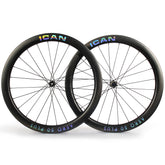Important tips for maintaining your carbon bike and its components
Introduction
Carbon bikes are known for their light weight, rigidity and exceptional performance. Proper care and maintenance is essential to ensure your carbon bike continues to provide top-notch performance and longevity. By following a few simple guidelines, you can keep your carbon bike and its components in excellent condition for years to come.

cleaning and maintenance
Before each ride, take a moment to inspect your carbon bike for any visible damage or cracks. Pay particular attention to impact-prone areas such as the frame, fork and handlebars. If you notice any signs of damage, it is important to address them promptly to prevent further complications.
After inspection, it's time to clean your carbon bike. Begin by removing dirt, mud, and debris from the frame, wheels, and components. Use a mild soap or special bike cleaner along with a soft brush or sponge to clean hard-to-reach areas. Avoid using high-pressure water as this can allow water to penetrate sensitive components. After cleaning is complete, dry the bike thoroughly to avoid water damage. After cleaning, rinsing and drying, we recommend applying a bike polish or spray wax to add an extra layer of protection.

lubrication and rust protection
Proper lubrication is essential to ensure smooth operation and long life of the drive train and moving parts. When choosing a lubricant for your carbon bike, choose one that is specifically designed for carbon components. Apply the lubricant to the chain, derailleurs, and brake pivots according to the manufacturer's instructions. Regular lubrication helps reduce friction, prevent premature wear and maintain optimal performance.
Also pay attention to metal parts that are susceptible to rust. Check metal parts such as screws, nuts, and other fasteners for signs of rust. Apply a protective coating or rust inhibitor if necessary to prevent corrosion and maintain the integrity of your carbon bike.

storage and transport
When you are not using your carbon bike, it is important to store it properly. Store it in a dry and air-conditioned environment to avoid moisture buildup that could cause corrosion or damage. It is important not to expose your bike and its components to high temperatures. This means you should not leave them in a car parked in the sun or store them near heat sources or radiators. If you live near an ocean where there is a lot of salt in the air, or if you sweat excessively, you should take special care to remove and rinse the salt from your bike and its components. This will protect the metal parts from possible corrosion.
Take precautions to protect your carbon bike from possible damage in transit. If you need to transport your bike, use a bike bag or suitcase suitable for travel. When transporting the bike, secure it well and protect the frame at the attachment points with pieces of foam.

inspection for damage and wear
Regular inspections are essential to detect potential problems early and prevent further damage. Establish a routine to check the frame and components for cracks, dents, or signs of damage. Pay particular attention to the areas where the stress is heaviest, such as: B. the bottom bracket, the seat stays and the head tube. If you notice any abnormalities or suspect damage, contact a professional for a thorough assessment.
In addition, the wheels should be checked for concentricity and spoke tension. Make sure the wheels turn smoothly without wobbling or rubbing against the brake pads. Check spoke tension and adjust as necessary to maintain optimal wheel performance.
Component-specific maintenance
Handlebars, seat posts and stems are important components that require special care. Periodically check the torque and tighten these parts according to the manufacturer's recommendations. Be careful not to overtighten as this may damage the carbon structure. When installing or adjusting carbon components, use carbon assembly paste to ensure a good grip and prevent slipping.
Carbon wheels require special attention, especially when it comes to braking. Periodically inspect the brake surface for signs of wear or damage. Avoid using incompatible brake pads as they can generate excessive heat and affect the carbon structure. Follow the manufacturer's guidelines for brake pad compatibility and maintenance to ensure safe and reliable braking performance.

Professional maintenance and repairs
While regular maintenance can be done by the bike owner themselves, regular professional maintenance is highly recommended. Professional bicycle repair shops have the expertise and specialized tools to perform comprehensive inspections and adjustments. You can check and fine-tune critical components such as the bottom bracket, headset and drivetrain to ensure optimal performance. By taking your carbon bike in for professional maintenance, potential problems can be identified and addressed before they escalate into larger problems.
The frequency of maintenance and service depends on factors such as driving conditions, mileage and usage patterns. Consult the manufacturer's recommendations or seek advice from a local bike shop to determine the appropriate maintenance intervals for your carbon bike.

Diploma
Caring for carbon bikes and parts is critical to ensuring their performance, longevity and safety. By following a proper cleaning routine, lubricating moving parts, checking for damage, and seeking professional maintenance when needed, you can keep your carbon bike in excellent condition for years to come. Remember that investing time and effort into the care and maintenance of your carbon bike will pay off in an improved riding experience and longer enjoyment of your two-wheeled companion.





